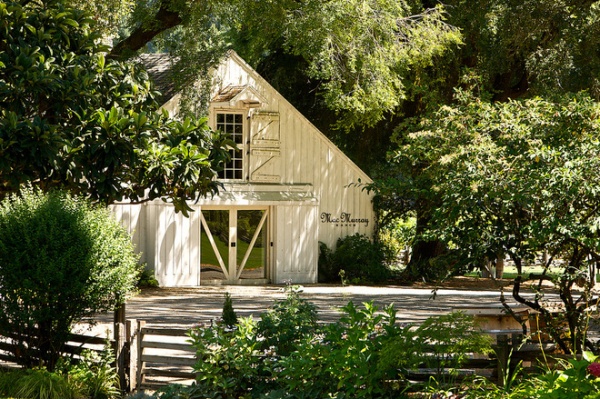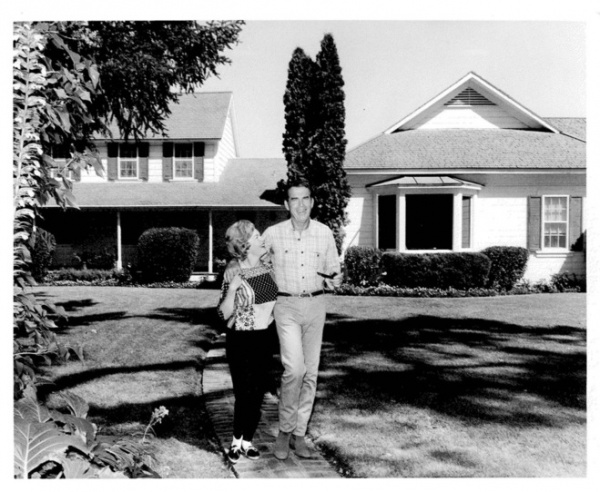Houzz Tour: Fred MacMurray’s Enduring Farmhouse Retreat
http://decor-ideas.org 08/17/2014 20:13 Decor Ideas
Although he considered his villainous roles his best (such as Walter Neff, the murder-minded insurance salesman in Double Indemnity); to his fans Fred MacMurray was synonymous with his more charming characters, such as the all-American television dad Steve Douglas on My Three Sons. According to his daughter Kate MacMurray, the latter character was closest to the real man.
The actor was known to millions for his work in more than 100 movies and many popular television shows, but what most admirers don’t realize is that he created a life for himself far from Hollywood on a ranch outside of Healdsburg, California.

He bought the Sonoma County spread, now called MacMurray Estate Vineyards, in 1941 and remodeled the existing farmhouse in a charming period style that has endured for more than 70 years. Today the property is owned by the Gallo family and produces lush pinot noir, pinot gris and chardonnay wines, but the house remains much as it did when MacMurray rode the 1,500 acres on horseback and raised prize-winning black Angus cattle.
Most of the time, the ranch is closed to the general public. But for the past several years, the crisp white gates of the grounds have been open during Taste of Sonoma, an August 30 event that is part of Sonoma Wine Country Weekend and features hundreds of wines and food from some of the region’s best chefs. In advance of the happening this year, Kate MacMurray takes us on a tour of the land her parents loved.
In Love With the Rolling Land
Kate says her father became acquainted with the area after years of fly-fishing in the Russian River. He became friendly with several locals, and through one of them, he met the Porter family. The Porters had been working the ranch since 1850, when their ancestors came west in a covered wagon. MacMurray, who was raised on the outskirts of agrarian activity in Illinois and Wisconsin, fell in love with the rolling land and magnificent vistas and bought it from the owners, who were retiring and wanted to move closer to town.
“Although Dad grew up in Beaver Dam, Wisconsin, his family had Scottish roots,” says Kate. “I think the landscape, with the haunting fog that often creeps over the hills, reminded him of Scotland. Although we lived in Los Angeles, this was the place my parents considered home.”
The original house (seen on the right in the photo) was a simple homestead built before the Civil War; shortly after the war, a more substantial two-story farmhouse was built (left). Fred MacMurray had the two structures joined by a hallway, which was later modified to become an open breezeway.


Today this barn holds photographs of the families who have touched the land — the Porters, the MacMurrays and the Gallos — but when Kate was growing up, it was used to store farm equipment and supplies. A good deal of the structure is dedicated to her father and mother.
MacMurray was no absentee landowner; he bought the farm with the intention of practicing diversified farming: He raised cattle, sheep and chickens, and had fruit orchards and gardens.
He and his wife, film actress June Haver, are seen here with a Black Angus raised on the ranch.

Inside, the house looks much the same as it did when the MacMurrays lived here. “My parents were children of the Depression,” says Kate. “They bought things with the intention that they would last. There was no thought of redecorating for style reasons. In fact, we had many pieces that had belonged to the Porter family. They liked them; the pieces worked; and so they hung on to them. They simply did not have a throwaway mentality.”
The effect is that of walking through a living museum, and the fact that almost all of the furniture and accessories are original to the house creates an authenticity that is rarely seen and nearly impossible to duplicate.
Daily Chores on the Farm
The kitchen is outfitted with green painted floors (more charming for the wear), white cabinets and an oak countertop Fred MacMurray made himself. “He made it with a lip that let the water drain back into the sink,” says Kate. “My sister and I were the dishwashers for the household, and one evening I told him I appreciated that lip. He explained that when he was in college, he earned money by washing dishes at a fraternity house. He hated how the water dripped from the countertop, so he had made sure to include this feature in the counter he built.”
The 1930s range still works, as do all the other vintage appliances. “The only thing we’ve had to replace is a lightbulb in the refrigerator,” says Kate.


Across from the kitchen is a breakfast nook, where Kate, her twin sister and their parents ate before starting the day’s chores. “I’m pretty sure we were the only children in Hollywood who shoveled manure and gathered eggs,” says Kate. “Now it’s popular to expose kids to fresh food and gardens, but our parents had the idea a long time ago. They wanted us to be close to nature and to know where our food came from.”
To the side of the table sits a cupboard that displays a portion of a family collection of dishes. The cupboard, like many things throughout the home, sports a crisp red hue. “Dad bought the ranch during the war, and there weren’t a lot of color choices,” says Kate. “However, Dad loved bright colors, and he really liked red — although the only red items he had in his wardrobe were a pair of socks and a sweater he wore on Christmas Day.”

The living room shows more of the simple country style the family favored. A rag rug covers the floor, and a red plaid sofa and chairs with wide wooden arms make for an unfussy place in which to relax. “The sofa — we called it a davenport when I was growing up — was made in the 1930s, but my parents had it re-covered,” says Kate. “My father was 6-foot-4, and he liked it because it was long. He would sack out on it sometimes.”
The window was one of the slight modifications MacMurray designed for the home. “We had the large window and window seat put in, and we used to enjoy sitting on it and looking out at the land in the evenings before dark,” Kate says. “When I was a young girl, I asked Dad why someone before us hadn’t thought of putting in a window to frame such a marvelous view. He laughed and said they were so busy working, they had no time to sit and enjoy looking out the window.”

The wall covering is another feature earlier residents didn’t get to enjoy. “Before us there never was wallpaper in the house. The previous family might have seen it as an unnecessary indulgence. I love this wallpaper — it shows sweet farm scenes,” Kate says. “It also represents the Gallos’ devotion to preserving the home. When a portion of this wallpaper was inadvertently damaged a few years ago, they hired an art historian to re-create the new panels. She carefully hand stenciled the pattern and did a lot of research to find exactly the same kind of wallpaper paste that was originally used to reapply it. It’s so worth it, because the pattern is like a beautiful memory that lives in the house.”

A fire screen is designed with the family’s initial. This area is where they often gathered. “At the ranch we had no television,” says Kate. “We read, talked and worked puzzles together. My parents had a love of reading they instilled in us. It was a very uncomplicated lifestyle.”
This is also where they occasionally entertained friends from Hollywood, such as Clark Gable, Red Skelton and Jimmy Stewart. “Jimmy filmed a movie in the area, at what is now Hop Kiln Winery,” says Kate. “He would often come over in the evenings after his work was done for the day.”

Originally, this dining room was the master bedroom. After the Gallo family bought the property, it was converted to a dining room for entertaining guests. During the process the wallpaper was removed and the beautiful redwood siding was revealed. It remains exposed for a cozy feeling.

The MacMurray family added a grill and a table on a back porch off the kitchen. “Before the houses were built, the Porter family constructed a platform and a roof. They used the canvas from their covered wagon to drape the structure and make a tent,” says Kate. “That platform became this porch after the house was finished.”


“It’s my understanding that in the olden days, the women of the house would dry herbs here,” Kate says. “Today it’s another place for entertaining Gallo clients and guests.” Kate says her father considered it a perfect spot for gathering, because the landscape serves as a beautiful backdrop.

When Fred MacMurray died in 1991, his family knew his hope for the ranch. “He wanted it to stay in an agricultural family, and he wanted the fence line to remain intact,” says Kate, seen here.
The wine-producing Gallo family was a logical choice. When they purchased the ranch in 1996, they began growing grapes there and producing MacMurray Ranch wines.
Kate knows her father would have approved. “He had thought about doing the same thing,” she says. “But he was getting older, and health issues prevented it.”

Today Kate MacMurray lives on the land in a cabin her father built and serves as a brand ambassador for the MacMurray Ranch label. “I’ve always felt a connection to the land, and I’m so honored to pick up the baton,” she says. “Seeing the land and the house being preserved agriculturally and architecturally is a great gift. I feel very blessed.”

She says her father, seen here with her mother in front of the house, shared that feeling. In an online journal, she writes: “Although he loved filmmaking and his career … his heart always found its way back home to his beloved ranch. He always said he was a lucky man. Indeed he was. And I was a lucky daughter to have known him.”
Tickets to Taste of Sonoma are available online. The Labor Day weekend event allows patrons to sample wine and food on the grounds of MacMurray Estate Vineyards. (The interior of the house will not be open to the public.)
More: Browse more farmhouses, new and old
Related Articles Recommended












